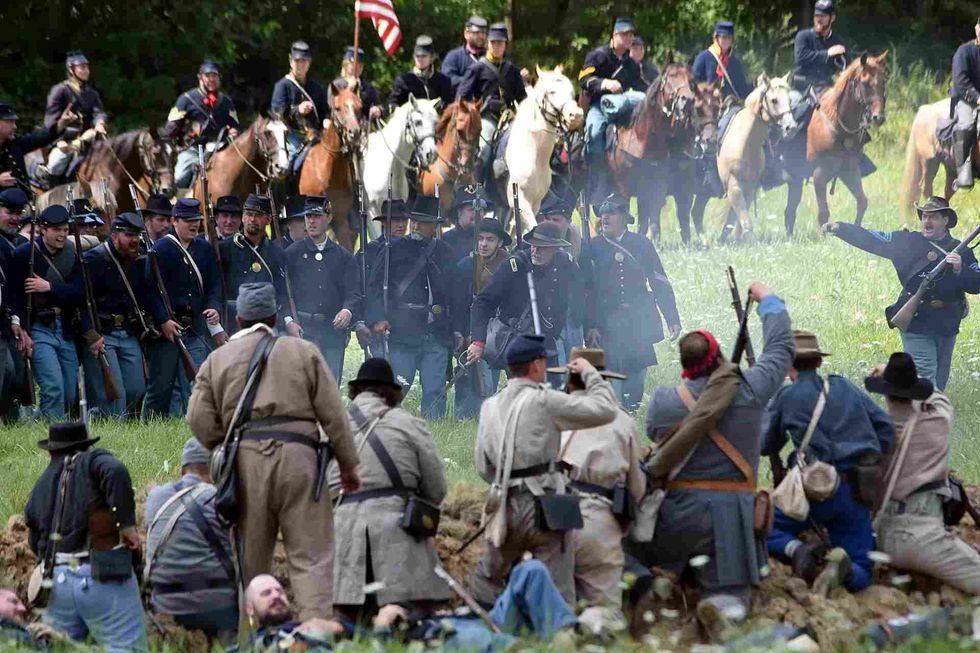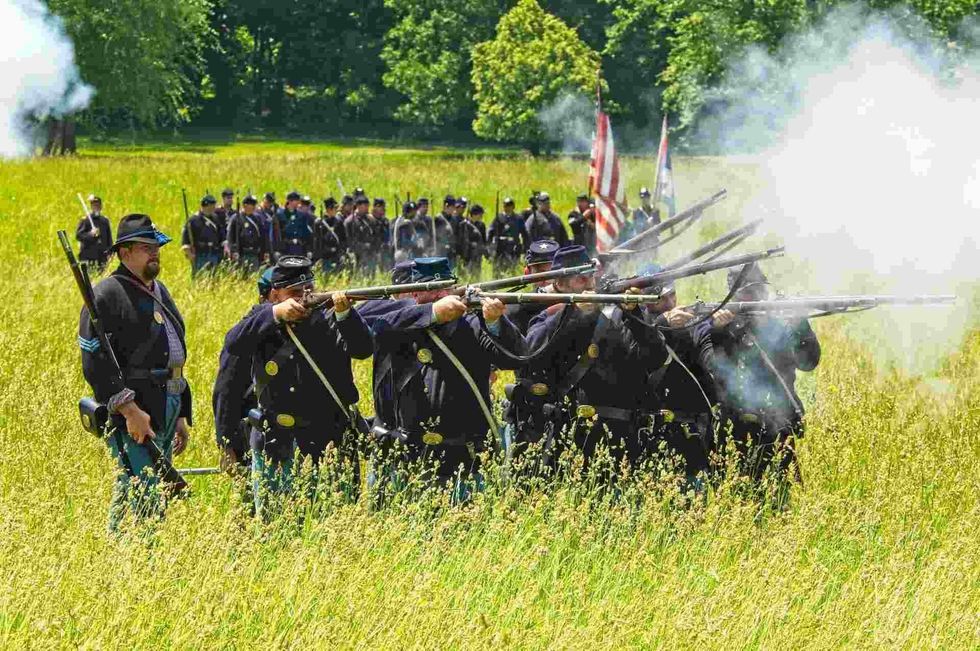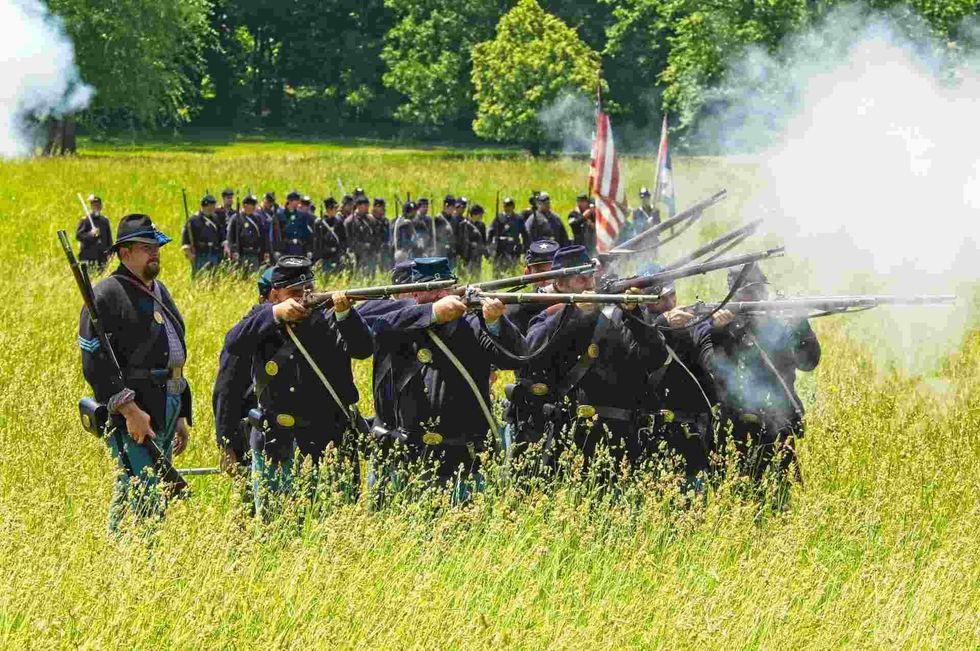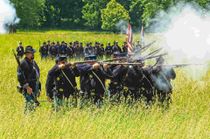First Battle Of Bull Run: Stats, Facts, Winner And More

The American Civil War is one of the most talked-about battles in the history of America.
The four-year-long war began in 1861 with the battle of Fort Sumter, but the most notable event was the First Battle of Bull Run, as it was the first major battle of the war. The Confederates used to refer to this battle commonly as the Battle of First Manassas.
The first battle of Bull Run took place on July 21, 1861, in the Prince William County of Virginia, located north of the city of Manassas at a 30 mi (48.3 km) distance from Washington DC. The battle was fought between the United States (Union) and Confederate States (Confederacy).
The Union capital was at Washington, and the Confederates of the South set up their new capital in Richmond, Virginia.
After the Sumter battle in April, the Union prepared for a march against the Confederates. However, they did not get sufficient time to gather experienced people, and under immense political pressure, General Irvin McDowell prepared a poorly trained army consisting of thousands of people.
On the other hand, the army of the Confederates led by General P.T. Beauregard was equally inexperienced.
General Irvin McDowell led this unseasoned army across Bull Run against the Confederates who were camped near the Manassas Junction. McDowell planned a surprise attack on the Confederates, which was poorly executed by his army. The Confederates' plan to attack the left flank was not carried out successfully.
There was a point in the battle when everyone thought the North would achieve victory. Many people even gathered to witness the Union victory, but the tables were soon turned.
At their breaking point, the Confederates got more troops, their call for reinforcements was answered by the Confederate Congress. More troops from Virginia and Shenandoah Valley under the leadership of Joseph E Johnston arrived at the battleground.
A famous general of the Confederates, Thomas J Jackson, stood at Henry House Hill like a stonewall, defending the Union attack. He ordered every soldier to yell like furies.
The rebel yell was a hallmark of the Confederate protest against the Union. With more men arriving, the Confederates pulled up a successful counter-attack, and the Union troop began to retreat slowly.
Since the army was inexperienced, many soldiers panicked, and they ran frantically without any order in the direction of Washington DC. The retreat soon turned into a riot.
If you are interested in learning more, keep reading the articles on Famous Pennsylvanians In History and famous people who died at the Alamo facts.
History Of The First Battle Of Bull Run
The First Battle of Bull Run was the first significant battle fought in the American Civil War. The battle was fought between the United States or the Union and the Confederate States or Confederacy. Even though the Union troops and the Confederate forces were equally inexperienced, the continuously pouring in army troops of the Confederates helped them win.
The Battle of Bull Run, a significant event in American history, was fought on July 21, 1861, right after the Civil War ensued. Only a few months before, the Civil War started in America with the Battle of Fort Sumter.
The Confederate troops of the South won the first battle at Sumter.
They were eager to end the battle and thought the Northern Union army would leave the newly formed Confederate States alone with another major Confederate victory. The North also strategized to capture the new Confederate capital city Richmond, Virginia, to end the war.
The Union army was led by General Robert Patterson and General Irvin McDowell, while the Confederate troops were led by General Joseph E. Johnston and P. G. T. Beauregard.
Irvin was under immense political pressure to lead an inexperienced Union force to win against the Confederates. He devised a plan to defeat the Confederate forces at Bull Run by dividing the union troops into two under the two generals.
On July 21, 1861, when McDowell ordered the Union forces to attack the South, both armies faced difficulties with coping.
The plan chalked by Irvin McDowell was good, but the inexperienced young soldiers could not implement the plan correctly. However, since the Union brigade had more soldiers, they pushed the Confederates to the point that it appeared it would be an easy Union victory.
With the heroic stunts pulled by Colonel Thomas Jackson, the Union troops were confined behind the stone wall of Henry Hill till reinforcements from Johnston's army arrived to join the battle.
Johnstons' troops and Patterson's troops together pushed back Union troops and assured the Confederate victory. It is said that Thomas Jackson standing behind Henry Hill, held the stone wall with so much power that the Union failed to break it.
This earned him the name Stonewall Jackson, and he was also one of the most important Confederate generals of the Civil War.
Total Deaths In The First Battle Of Bull Run
The Battle of Bull Run was the first battle of the Civil War.
There was immense bloodshed in the battle, and several men belonging to both parties either lost their lives or were severely injured. Compared to other Civil War battles that were yet to come when the first battle of Bull Run was fought, the number of casualties was less.
However, as the first major battle of the war, the first Bull Run battle was an early indication of the magnitude of damage that the Civil War would cause in the future.
The Union Commander General, Irvin Mcdowell, formed a troop consisting of approximately 28,400 men, and they marched from Washington D.C. to Virginia. There, the Confederate army consisting of around 21,900 men were waiting for the Union force to arrive under the command of Brigadier General P.G.T.
Beauregard.
By the afternoon of July 21, 1861, approximately nine thousand men under the command of Confederate General Joseph Johnston joined Beauregard's army.
Out of 28,400 men in the Union army, roughly 480 men lost their lives. A thousand men were severely injured, and 1,200 men went missing from the federal troops.
The total number of losses from the federal side in the First Battle of Bull Run was 2680 casualties, almost nine and a half percent of their entire army. For the Confederates, the total number of losses stood at approximately 2,000 casualties which were a little more than six percent of the whole troop.
Combining Beauregard's and Johnston's troops, there were around 30,800 men in the Confederate troop, out of which 1600 people were injured, a dozen people went missing, and 390 men died.
The most significant loss for the Union was in the missing category of the people lost. More than a thousand people went missing after the war started in the Union army, which was a hundred times greater than the number of the Confederates.
Many of the Union soldiers were taken as prisoners after the first battle of Bull Run and sent to Richmond, the capital of Confederates.
The prisoners were sent to cities further south like North Carolina and Salisbury from Richmond. From the first battle of Bull Run, the concept of prisoner exchange started between the North and the South that allowed many prisoners to retreat back in their actual positions.
Important Dates From The First Battle Of Bull Run
The bells of the first major battle of the Civil War rung when an army of approximately 35,000 men marched towards Virginia from Washington under the leadership of General Irvin McDowell. The Union troops started their march from Washington towards Richmond on July 16, 1861.
It was the starting period of the American Civil War, and no one had any idea about how intense the war was going to be. The war started with the Fort Sumter burst in the nation in April 1861.
On July 16, when the Union forces began marching towards Richmond, they only covered 5 mi (8 km). They were headed for the Manassas Junction, which led to the Shenandoah Valley.
On July 18, the army reached Centerville.
The Confederate troops joined forces between July 20 and 21, some arriving directly on the battlefield. On July 21, 1861, the Union troops reached the Sudley Springs Ford in the early morning hours.
The deep roar of the 30-pounder Parrott rifle at 5:30 in the morning of July 21 announced the start of the battle, and it went on for around 12 hours. Finally, at 5:30 pm, the first battle of Bull Run ended with the Confederates emerging victorious.

Who Won, Facts Of The First Battle Of Bull Run
The first battle of Bull Run took place after a few months after the Civil War started. The brigadier generals of both sides prepared equally inexperienced armies to fight in the first battle, which later became the first major battle of the Civil War.
The War took place at the southern banks of Bull Run river located near the Manassas Junction.
The First Battle of Bull Run ended up being a victory for the Confederates, with both sides suffering a large number of casualties. The Confederate President, Jefferson Davis, arrived at Bull Run just to see the Union army retreat.
However, their forces were not organized enough to pursue the federal. One of the famous parts of the battle was the event of Henry Hill House.
Beauregard ordered his massive counter-attack, and for over two hours, 10,000 men pushed the 4,500 Confederates up the hill. Thomas Jackson urged the soldiers to give out furious yells.
The rebel yell was a hallmark of the Confederate line. People started crowding to watch the federal cavalry until reinforcements from the confederate artillery reached the hill and fought till they defeated the North.
Even though this was a battle of considerable magnitude with around 60,000 men fighting on the battlefield, only 18,000 actually participated from both sides. This bloody battle made the Union and Confederates realize that the Civil War would be prolonged and horrible.
The immense force of General Irwin McDowell was routed by the army led by Confederate general G.T.
Beauregard. The battle started with the belief of the Union military command that the Confederates could be crushed easily without the loss of many lives.
This overconfidence was the leading cause behind the premature battle near Manassas in Northern Virginia.
On his search to find men for the army, General McDowell organized a troop of 34,000 primarily inexperienced and poorly trained military men of the North. Later on July 21, 1861, he went to Bull Run, located 30 mi (48.3 km) from Washington, intending to capture the capital from the Confederates with his mishandled troop.
Alerted by the advance of the Union army, General P. T. Beauregard also gathered roughly around 20,000 men and camped by the stream Bull Run.
He was soon joined by the troop of General Joseph J Johnston, who brought around 9,000 men through the railroad from Shenandoah Valley. The Confederates were also joined by a small troop led by Colonel Nathan Evans, who was commanding at Stone Bridge.
Evans rushed with his force to Matthews hill, but his army was too small to hold back the Federals.
The battle continued for several hours on the 21st, on the top of Henry House Hill just by the home of Mrs. Judith Henry.
Each party took control of the hill more than once, and at one point, it seemed as if the Northerners would win the battle. However, as more and more southern men poured on the battlefield, the Confederate defense became powerful and gradually pushed back the Northerners.
Thomas Jackson played a significant role in pushing back the Northern army, and from that point onwards, he came to be known as Stonewall Jackson.
The strength of the inexperienced army of McDowell slowly wore out as the day went on, and they grew tired of the continuous arrival of the Southern reinforcements one after another. Eventually, McDowell's army fell to the Confederates and started retreating from the hill.
The Union began to retreat in order at first, but as the Confederates destroyed the main retreat route, they panicked. The untutored army began to rout frantically towards Washington, overwhelmed by the situation.
The carts and wagons in which the Union troops came clogged the narrow roads of Virginia. The people who came to witness the battle also hampered the retreat.
The Confederates tried to pursue the Union troops, but they failed because of the army's disorganized nature. The Northerners attempted to cross the Manassas after more than a year since the morning of July 22.
Notable Deaths In The First Battle Of Bull Run
The first battle of Bull Run saw many casualties for both parties. Many first division officers, including the officers from other divisions, died in this bloody battle. Some of them were notable soldiers of both the federal and the Confederate armies.
The Union casualties in Bull Run included six dead officers of the first division, 19 wounded, and 19 missing. In the second division, six officers were dead, 12 others were injured, and 11 went missing.
In the third division also, six officers died while no officer died in the fourth division, but a few went missing. For the Confederates, a total of 25 officers died after the battle, 63 were wounded, and one went missing.
The battle ended with an unanticipated number of casualties on both sides.
The motive of both the parties was to end the battles as fast as they could so they could live freely in their new state. However, the fierce fighting made the people of America realize that the battle was going to last for quite a while.
Here at Kidadl, we have carefully created many interesting family-friendly facts for everyone to enjoy! If you liked our suggestions for the first battle of Bull Run: stats, facts, winner, and more, then why not take a look at51 famous Pennsylvanians in history you should definitely know about orBattle of The Little Bighorn facts?
We Want Your Photos!
More for You
Bachelor of Arts specializing in Linguistics

Martha MartinsBachelor of Arts specializing in Linguistics
Martha is a full-time creative writer, content strategist, and aspiring screenwriter who communicates complex thoughts and ideas effectively. She has completed her Bachelor's in Linguistics from Nasarawa State University. As an enthusiast of public relations and communication, Martha is well-prepared to substantially impact your organization as your next content writer and strategist. Her dedication to her craft and commitment to delivering high-quality work enables her to create compelling content that resonates with audiences.
Disclaimer
1) Kidadl is independent and to make our service free to you the reader we are supported by advertising. We hope you love our recommendations for products and services! What we suggest is selected independently by the Kidadl team. If you purchase using the Buy Now button we may earn a small commission. This does not influence our choices. Prices are correct and items are available at the time the article was published but we cannot guarantee that on the time of reading. Please note that Kidadl is a participant in the Amazon Services LLC Associates Program, an affiliate advertising program designed to provide a means for sites to earn advertising fees by advertising and linking to Amazon. We also link to other websites, but are not responsible for their content.
2) At Kidadl, we strive to recommend the very best activities and events. We will always aim to give you accurate information at the date of publication - however, information does change, so it’s important you do your own research, double-check and make the decision that is right for your family. We recognise that not all activities and ideas are appropriate for all children and families or in all circumstances. Our recommended activities are based on age but these are a guide. We recommend that these ideas are used as inspiration, that ideas are undertaken with appropriate adult supervision, and that each adult uses their own discretion and knowledge of their children to consider the safety and suitability. Kidadl cannot accept liability for the execution of these ideas, and parental supervision is advised at all times, as safety is paramount. Anyone using the information provided by Kidadl does so at their own risk and we can not accept liability if things go wrong.
3) Because we are an educational resource, we have quotes and facts about a range of historical and modern figures. We do not endorse the actions of or rhetoric of all the people included in these collections, but we think they are important for growing minds to learn about under the guidance of parents or guardians.







